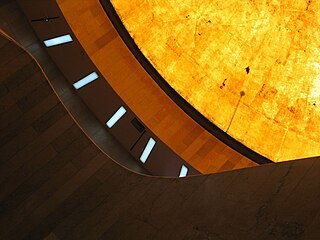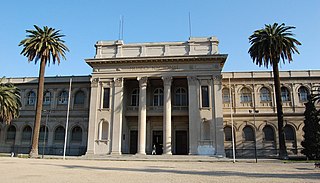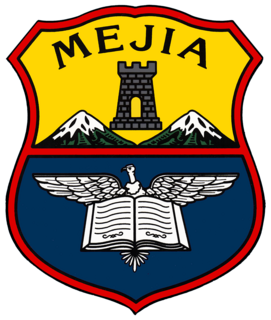
La Plata is the capital city of Buenos Aires Province, Argentina. According to the 2010 census [INDEC], it has a population of 193,144 and its metropolitan area, the Greater La Plata, has 787,294 inhabitants.

The National University of Colombia is a public and national research university in Colombia, with general campuses in Bogotá, Medellín, Manizales and Palmira, and satellite campuses in Leticia, San Andrés (island), Arauca, Tumaco and La Paz, Cesar. It was established in 1867 by an act of the Congress of Colombia, and it is one of the largest universities in the country, with more than 53,000 students. It grants many academic degrees and offers 450 academic programmes, including 95 undergraduate degrees, 83 academic specializations, 40 medical specialties, 167 master's degrees, and 65 doctorates. Approximately 44,000 students are enrolled for an undergraduate degree and 8,000 for a postgraduate degree. It is also one of the few universities that employs post-doctorate fellows in the country.

The National Museum of Anthropology is a national museum of Mexico. It is the largest and most visited museum in Mexico. Located in the area between Paseo de la Reforma and Mahatma Gandhi Street within Chapultepec Park in Mexico City, the museum contains significant archaeological and anthropological artifacts from Mexico's pre-Columbian heritage, such as the Stone of the Sun and the Aztec Xochipilli statue.

The Natural History Museum in Lima, is Peru's most important museum of natural history. It was established in 1918 and belongs to the National University of San Marcos.

The Museo de Arte Moderno is located in Chapultepec park, Mexico City, Mexico.

Machaquila is a major ruined city of the Maya civilization in what is now the El Peten department of Guatemala.

The National Museum of Natural Sciences is the national museum of natural history of Spain. It is situated in the center of Madrid, by the Paseo de la Castellana. It is managed by the Spanish National Research Council (CSIC).
There are several national anthropological museums. As such, National Museum of Anthropology may refer to:

The Chilean National Museum of Natural History is one of three national museums in Chile, along with the Museum of Fine Arts and the National History Museum. It is located in Quinta Normal Park.

José de Ibarra (1685–1756) was a Mexican painter, born in Guadalajara, Mexico, and died 21 Nov 1756 in Mexico City, in the Viceroyalty of New Spain.

The Plomo Mummy is the well preserved remains of an Incan child found on Cerro El Plomo near Santiago, Chile in 1954. It was discovered by Guillermo Chacón Carrasco, Jaime Ríos Abarca, and Luis Gerardo Ríos Barrueto. The mummy was brought to the attention of Grete Mostny at the Chilean National Museum of Natural History; she later proved instrumental in the museum's acquisition of the specimen. The Plomo Mummy was the first notable frozen mummy discovery of high-altitude Capacocha human sacrifice by the Incas, a practice called qhapaq hucha.
The Museo Nacional de Arte Moderno "Carlos Mérida" is a national museum of modern art in Guatemala City, named after Carlos Mérida.
The Guatemalan National History Museum or Museo Nacional de Historia is a national museum in Guatemala City, Guatemala.

Instituto Nacional Mejía is a public secondary educational institution of Quito. It was founded on June 1, 1897 by Eloy Alfaro Delgado, then president of Ecuador.

The Museo Regional del Sureste de Petén is an archaeological museum in the town of Dolores in the Petén Department of Guatemala. The museum is located 82 kilometres (51 mi) from Flores, the departmental capital, among the Maya Mountains in an area rich in archaeological sites. It is open daily from 8am to 5pm.
Juan Pedro Laporte Molina was a prominent Guatemalan archaeologist best known for his work on the ancient Maya civilization. He studied in the United States at the University of Arizona, in which he enrolled at the age of nineteen. After just one year he transferred to the Escuela Nacional de Antropología e Historia in Mexico. He continued his studies at the Universidad Autónoma de México from 1972 to 1976, from which he graduated with a doctorate in archaeology. He worked as a research assistant at the Museo Nacional de Antropología in Mexico City from 1967 through to 1976. Laporte worked at various archaeological sites while he was in Mexico, including Tlatilco, Chichen Itza and Dainzú. He first began working as an archaeologist in Guatemala in the 1970s, and was the head of the School of History of the Universidad de San Carlos de Guatemala (USAC) for more than thirty years. He first entered USAC in 1977, soon after returning from Mexico. In 1974 he carried out investigations at the Maya archaeological site of Uaxactun in the northern Petén Department of Guatemala. Between 1974 and 1976 he carried out archaeological investigations in Antigua Guatemala, which has since been designated as a UNESCO World Heritage Site, and around Lake Izabal.
The Museo Nacional de Historia Natural Cubana or Museo Nacional de Historia Natural de Cuba in Havana, Cuba is the national museum of Natural History, with exhibits which "promote knowledge about nature, defending the need to preserve Cuba’s natural wealth".

Mélica Elisa Muñoz-Schick is a Chilean botanist noted for her work curating the collections of the herbarium at the Chilean National Museum of Natural History, as well as her research into the flora of Chile. The standard author abbreviation Muñoz-Schick is used to indicate this person as the author when citing a botanical name.
Rebeca Acevedo was a Chilean professor and botanist. She was the first woman to head the botanical department of the Chilean National Museum of Natural History in 1947.













